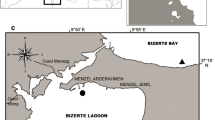Abstract
The effects of light intensity, inoculum volume, sodium nitrate and carbon dioxide concentrations on the growth of Haematococcus pluvialis were investigated using response surface methodology (RSM). All the four variables exhibited significant effects on growth and can be related (r ≥ 0.926, P ≤ 0.01) by a second-order polynomial consisting of linear, quadratic and interaction terms. The total quadratic effect (P ≤ 0.01) dominates over the total linear effect (P ≤ 0.01) but the role of interaction terms (P ≤ 0.10) is marginal. The optimum values of these variables were: carbon dioxide 1.54%, sodium nitrate 1.06 g/l, inoculum volume 24.97% and light intensity 2.42 klux; the predicted maximum value for the yield of biomass was 0.51 g/l (dry weight).
Similar content being viewed by others
References
Akhnazarova, S. & Kafarov, V. 1982 Experiment Optimization in Chemistry and Chemical Engineering, pp. 151–240. Moscow: MIR Publishers.
Bhattacharya, S. & Prakash, M. 1994 Extrusion cooking of blends of rice and chickpea flour: a response surface analysis. Journal of Food Engineering 21, 315–330.
Boussiba, S. & Vonshak, A. 1991 Astaxanthin accumulation in the green alga Haematococcus pluvialis. Plant Cell Physiology 32, 1077–1082.
Boussiba, S., Bing, W., Yuan, J.P., Zarka, A. & Chen, F. 1999 Changes in the green alga Haematococcus pluvialis exposed to environmental stresses. Biotechnology Letters 21, 601–604.
Ding, S.Y., Chu, W.S., Yong, Y.Y., Bee, P.L. & Lee, Y.K. 1994 Production strategies of astaxanthin by growing of Haematococcus lacustris cells. In Proceedings of Algal Biotechnology in the AsiaPacific Region, eds. Phang, F.M., Lee, Y.K., Borowitzka, M.A. and Whitton, B.A. pp. 28–32. Kuala Lumpur: University of Malaya.
Droop, M.R. 1954 Conditions governing haematochrome formation and loss in the alga Haematococcus Pluvialis Flotow. Archives of Microbiology 20, 391–397.
Fabregas, J., Dominguez, A., Alvarez, D., Lamela, T. & Otero, A.1998 Factors controlling the production of astaxanthin in Haematococcus pluvialis. Biotechnology Letters 20, 623–626.
Fabregas, J., Dominguez, A., Regueiro, M., Maseda, A. & Otero, A. 2000 Optimization of culture medium for the continuous cultivation of the microalga Haematococcus pluvialis. Applied Microbiology and Biotechnology 53, 530–535.
Gong & Chen 1998 Influence of medium components on astaxanthin content and processing of Haematococcus Pleucialis. Process Biochemistry 33, 385–391.
Husemann, W. & Barz, W. 1977 Photoautotrophic growth and photosynthesis in cell suspension cultures of Chenopodium rubrum. Physiologia Plantarum 40, 77–81.
Kanz, T. & Bold, H.C. 1969 In Physiological Studies 9. Morphological and Taxonomic Investigations of Nostoc and Anabaena in Culture, University of Texas publ. no. 6924. Austin, Texas: University of Texas.
Khuri, A.I. & Cornell, J.A. 1987 Response surfaces: designs and analyses, pp. 19–69. New York: Marcel Dekker, ISBN 0-82477653-4.
Kobayashi, M., Kurimuru, Y. & Tsuji, Y. 1997 Light independent astaxanthin production by the green microalga Haematococcus pluvialis under salt stress. Biotechnology Letters 19, 507–509.
Little, T.M. & Hills, F.J. 1978 Agricultural Experimentation: Design and Analysis, pp. 247–266. New York: John Wiley. ISBN 0-471-02352-3.
Lorenz, T.R. & Cysewski, G.R. 2000 Commercial potential for Haematococcus microalgae as a natural source of astaxanthin. Trends in Biotechnology 18, 160–167.
Myers, R.H. 1971 Response Surface Methodology, pp. 61–106. Boston: Allyn and Bacon.
Tjahjono, A.E., Hayama, Y., Kakizono, T., Tereda, Y., Nishio, N. & Nagai, S. 1994 Hyper accumulation of astaxanthin in a green alga Haematococcus pluvialis at elevated temperature. Biotechnology Letters 16, 133–138.
Usha, T., Sarada, R., Ramachandra Rao, S. & Ravishankar, G.A. 1999 Production of astaxanthin in Haematococcus pluvialis cultured in various media. Bioresource Technology 68, 197–199.
Usha, T., Sarada, R. & Ravishankar, G.A. 2001 A culture method for micro algal forms using two-tier vessel providing carbon dioxide environment: studies on growth and carotenoid production. World Journal of Microbiology and Biotechnology 17, 325–329.
Author information
Authors and Affiliations
Rights and permissions
About this article
Cite this article
Sarada, R., Bhattacharya, S. & Ravishankar, G. Optimization of culture conditions for growth of the green alga Haematococcus pluvialis . World Journal of Microbiology and Biotechnology 18, 517–521 (2002). https://doi.org/10.1023/A:1016349828310
Issue Date:
DOI: https://doi.org/10.1023/A:1016349828310




